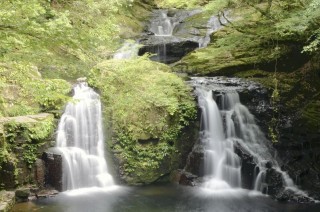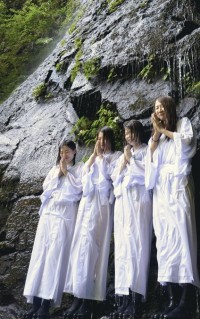Loading
Search
▼ Get Tough Like a Ninja at Famed Waterfalls
- Category:Mountain
NABARI, Mie — I wanted to take a walk somewhere off the beaten track, where in ancient times mountain ascetics are said to have toughened their minds and bodies. And where, later, the ninja of Iga Province (the northwestern part of present-day Mie Prefecture) did the same during the Sengoku warring states period from the late 15th century to the late 16th century and in the Edo period (1603-1867). So I paid a visit to Akame Shijuhachitaki (literally, red eye 48 waterfalls) in Nabari, Mie Prefecture.
Strolling along the gorge’s walking trail, about five minutes by foot from the mountain entrance, I caught sight of a statue of a cow with red eyes.
The area owes its name — Akame — to En no Gyoja, the founder of mountain asceticism who came here in the seventh century to train himself. There is a legend that the Buddhist deity Fudo-myoo, riding on a red-eyed cow, appeared before Gyoja.
After about five more minutes, I encountered a marker indicating the way to Dainichi Falls. Leaving the trail, I climbed up a winding path made of natural stones embedded in the steep slope, holding onto a rope affixed to the side of the path, my heart pounding all the way.
After a climb of about 90 meters, I caught sight of a group of people dressed in white, standing in front of a waterfall. They were participants in the “toughen yourself by standing under a waterfall ecotour,” which the nonprofit Akame Shijuhachitaki Association — the entity that manages the whole area — has been running since 2012.
The participants stood under the waterfall amid yelps of, “It’s cold!” Shigeki Masuda, 53, deputy president of the association, explained, “They say the roots of the ninja go back to the mountain ascetics who trained themselves in the recesses of the mountains.”
Strolling along the gorge’s walking trail, about five minutes by foot from the mountain entrance, I caught sight of a statue of a cow with red eyes.
The area owes its name — Akame — to En no Gyoja, the founder of mountain asceticism who came here in the seventh century to train himself. There is a legend that the Buddhist deity Fudo-myoo, riding on a red-eyed cow, appeared before Gyoja.
After about five more minutes, I encountered a marker indicating the way to Dainichi Falls. Leaving the trail, I climbed up a winding path made of natural stones embedded in the steep slope, holding onto a rope affixed to the side of the path, my heart pounding all the way.
After a climb of about 90 meters, I caught sight of a group of people dressed in white, standing in front of a waterfall. They were participants in the “toughen yourself by standing under a waterfall ecotour,” which the nonprofit Akame Shijuhachitaki Association — the entity that manages the whole area — has been running since 2012.
The participants stood under the waterfall amid yelps of, “It’s cold!” Shigeki Masuda, 53, deputy president of the association, explained, “They say the roots of the ninja go back to the mountain ascetics who trained themselves in the recesses of the mountains.”
He added: “Even when, like now, there is less water in the waterfall and the weather is warm, your body still feels it. The mountain ascetics and ninja stood under waterfalls even when it was cold and there was lots of water, pushing themselves to the limits of endurance.”
Azusa Mine, 23, from Kobe, said, “I came here to stand under the waterfall,” adding, “I spend all my time in the city, so coming into contact with nature feels like I have been born again into a new self.”
I joined the participants in attempting meditation, with Masuda giving instructions: “Close your eyes and breathe out.” “Breathe in.” With nothing to hear but rasping cicadas and flowing water, it felt as though I had been spirited away to another place.
Returning to the trail, I walked up the gorge. I encountered waterfalls one after the other: Senju Falls, which splits into branches as it flows over a rock; Nunobiki Falls, which resembles a white cloth as the water falls from a height of 30 meters; and other cascades.
After I had walked about an hour, there before my eyes was Ninai Falls, a gracefully flowing waterfall split in two. In the about three hours of my seven-kilometer round trip, I enjoyed views of a variety of waterfalls.
At the Ninja Forest and the torrents outside the entrance to the mountain, a large number of parents and children dressed as ninja were assiduously “training” themselves. Masuda, who has been putting on this “ninja training experience” program since 2010, explained the goal: “People only know the side of ninja that they get from things like movies — that is, flashy action. We want them to also know that there was another side to ninja, how they worked strenuously to toughen themselves in natural settings.”
That goal seemed to be communicating itself to the participants. I watched as little Kaj Horowitz, 7, who had come all the way from the United States, tried his hand at “the art of the water-spider board,” perched on a tire while holding a rope stretched across the river. Toshio Nakano, 76, his grandfather who has been living in the United States for 30 years, smiled as he declared enthusiastically: “The tour of the waterfalls was also fantastic, and I’ve had the chance to see what Japan is really like!”
Why not give it a try?
At the Uedaya souvenir store, located near the entrance to the mountain, chain mail and other items passed down through local families that descend from ninja are displayed. In the 12 months up until May 31, about 163,000 people visited the Akame Shijuhachitaki waterfalls and about 11,000 people took part in the “ninja training experience” program.
To apply for these experiences or the “toughen yourself by standing under a waterfall ecotour,” apply at the ecotour desk of the Akame Shijuhachitaki Association at least two days prior to the day you want to participate.
■ Travel tips
From JR Tokyo Station, first take the Shinkansen bullet train to Nagoya, which takes about 1 hour and 40 minutes. From Nagoya Station, take the Kintetsu express train to Akameguchi Station, which takes another 1 hour and 40 minutes. From the station, a 10-minute bus ride operated by Mie Kotsu Co. will take you to Akamedaki, the closest bus stop to the Akame Shijuhachitaki waterfalls.
For more information, visit http://ninja-valley.com/, or call (0595) 64-2695.
Azusa Mine, 23, from Kobe, said, “I came here to stand under the waterfall,” adding, “I spend all my time in the city, so coming into contact with nature feels like I have been born again into a new self.”
I joined the participants in attempting meditation, with Masuda giving instructions: “Close your eyes and breathe out.” “Breathe in.” With nothing to hear but rasping cicadas and flowing water, it felt as though I had been spirited away to another place.
Returning to the trail, I walked up the gorge. I encountered waterfalls one after the other: Senju Falls, which splits into branches as it flows over a rock; Nunobiki Falls, which resembles a white cloth as the water falls from a height of 30 meters; and other cascades.
After I had walked about an hour, there before my eyes was Ninai Falls, a gracefully flowing waterfall split in two. In the about three hours of my seven-kilometer round trip, I enjoyed views of a variety of waterfalls.
At the Ninja Forest and the torrents outside the entrance to the mountain, a large number of parents and children dressed as ninja were assiduously “training” themselves. Masuda, who has been putting on this “ninja training experience” program since 2010, explained the goal: “People only know the side of ninja that they get from things like movies — that is, flashy action. We want them to also know that there was another side to ninja, how they worked strenuously to toughen themselves in natural settings.”
That goal seemed to be communicating itself to the participants. I watched as little Kaj Horowitz, 7, who had come all the way from the United States, tried his hand at “the art of the water-spider board,” perched on a tire while holding a rope stretched across the river. Toshio Nakano, 76, his grandfather who has been living in the United States for 30 years, smiled as he declared enthusiastically: “The tour of the waterfalls was also fantastic, and I’ve had the chance to see what Japan is really like!”
Why not give it a try?
At the Uedaya souvenir store, located near the entrance to the mountain, chain mail and other items passed down through local families that descend from ninja are displayed. In the 12 months up until May 31, about 163,000 people visited the Akame Shijuhachitaki waterfalls and about 11,000 people took part in the “ninja training experience” program.
To apply for these experiences or the “toughen yourself by standing under a waterfall ecotour,” apply at the ecotour desk of the Akame Shijuhachitaki Association at least two days prior to the day you want to participate.
■ Travel tips
From JR Tokyo Station, first take the Shinkansen bullet train to Nagoya, which takes about 1 hour and 40 minutes. From Nagoya Station, take the Kintetsu express train to Akameguchi Station, which takes another 1 hour and 40 minutes. From the station, a 10-minute bus ride operated by Mie Kotsu Co. will take you to Akamedaki, the closest bus stop to the Akame Shijuhachitaki waterfalls.
For more information, visit http://ninja-valley.com/, or call (0595) 64-2695.
- September 8, 2016
- Comment (0)
- Trackback(0)



